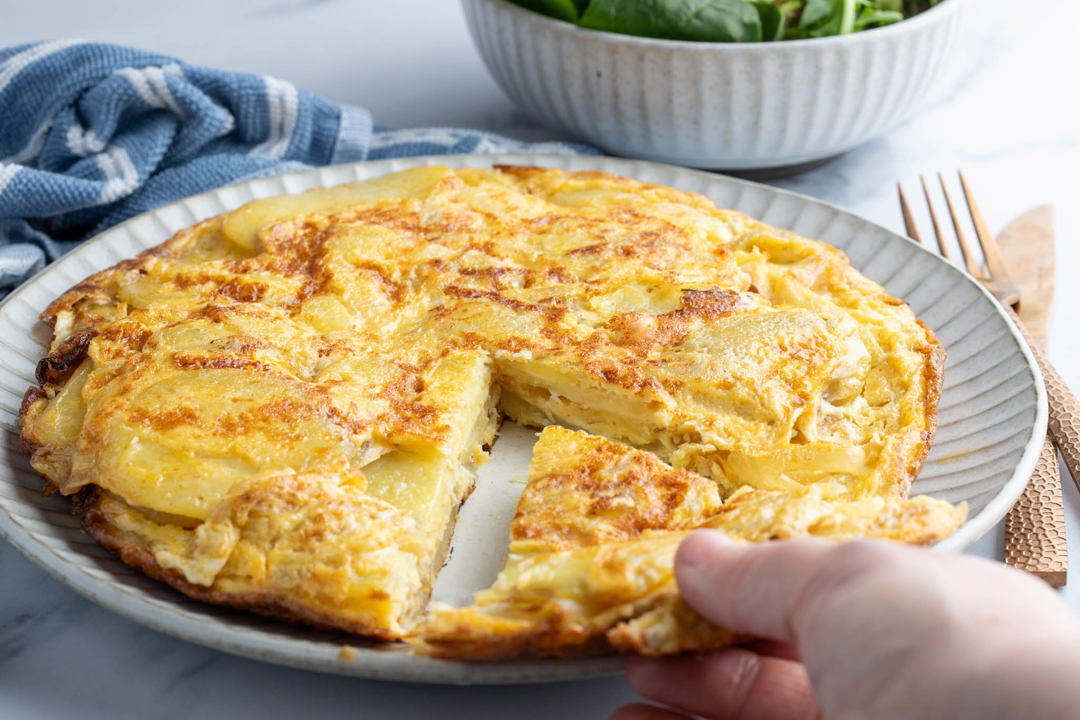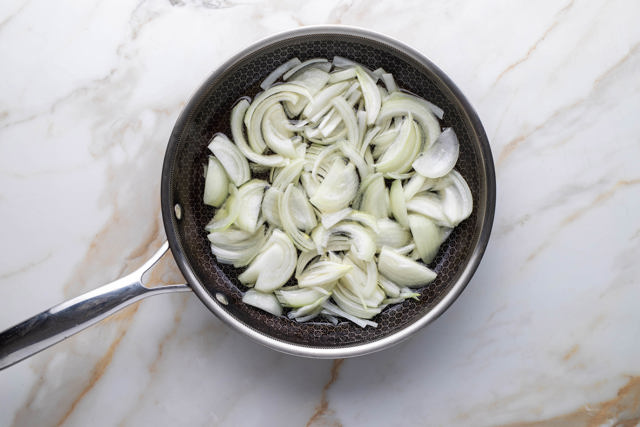I'm a huge fan of meze/tapas/antipasti/izakaya style dishes - light meals, shared socially with friends.
Spanish omelette - also known as tortilla española - is a classic Spanish dish that's simple and satisfying. Essentially, it's a thick omelette made with eggs and potatoes, sometimes with onions added; my recipe uses onions because they bring a fantastic sweetness to the dish.
The omelette is perfect to serve as tapas or main course - just serve it with a side salad to make it a more substantial meal. It's great hot, cold or room temperature, making it perfect for picnics or packed lunches.
As with any recipe containing so few ingredients, it's all about technique to get the best result. Follow on to learn my tips for the best Spanish omelette.
Ingredients for Spanish omelette
- Onion - optional, but often added. Leave it out if you want, but it adds a good depth of flavour and sweetness.
- Potatoes - waxy potatoes work best as they hold their shape when cooked and won't fall apart. See suggested varieties for more information.
- Eggs - use the freshest free-range eggs for the best result.
- Salt - to taste.
- Olive oil - use a good quality olive oil, preferably Spanish. Don't use extra virgin olive oil; alternatively you could use a neutral vegetable oil.
How to make Spanish omelette
Prep ingredients - peel and thinly slice the potatoes to around 3-4mm thick (1/8"). Beat the eggs in a large bowl. If you're using onions, halve them and slice thinly. Use a food processor or mandoline for the best results.
Cook potato and onion - heat olive oil in a large (10") skillet over medium-low heat, and bring the oil temperature to about 110C (230F). If using onions, add them first (1) and cook for about 8-10 minutes until tender, stirring occasionally - don't brown them. Once the onions are soft (2), carefully add the potato slices (3), taking care not to spill the hot oil. Cook, stirring occasionally, until the potatoes are tender and cooked through (4), about 10-15 minutes - don't brown the potatoes.
Drain oil from the potato and onion mixture, using a strainer over a large bowl (1). Reserve the oil. Immediately add the potato and onion mixture to the beaten eggs and stir gently to combine (2) - the heat should start to slowly cook the eggs.
Cook omelette - add 1 tablespoon of the reserved oil back to the skillet. Pour in the egg mixture, spreading the potatoes and onions evenly (1). Continue cooking until the omelette is mostly set and the bottom is golden, about 8 minutes (2).
Flip and finish - loosen the edges of the omelette with a spatula (1). Place a large plate over the skillet (2) and quickly flip the omelette onto it. The cooked side will be facing up on the plate (3) - slide the omelette back into the pan to cook the uncooked side until golden, about 5 minutes.
Serve - once both sides are golden and the omelette is cooked through, slide it onto a serving plate. Let it cool for a few minutes before slicing and serving.
Tips for the perfect Spanish omelette
- Slice the potatoes thinly (but not too thin!) and evenly for consistent cooking. You don't want them to fall apart.
- Don't let the potatoes or onion brown when cooking - you want them soft, not crispy.
- Use plenty of oil when cooking the potatoes and onions - the excess is drained off and you can reuse it later.
- Watch the oil temperature if you have a thermometer - you want to keep it around 120C, which will avoid the onion or potato from browning or burning.
What to serve with Spanish omelette
If you want to serve this as a main, serve with mixed green leaves dressed with a little oil and vinegar, or a side salad. I'd recommend my Roasted beetroot with hazelnuts, orange, yoghurt and honey if you want something a little different to try!
If you want to do a tapas spread, here are some recipes you could try:
- Patatas Bravas - fried potatoes served with a spicy tomato-based sauce and a dollop of aioli.
- Croquetas - fried breaded rolls filled with a creamy mixture of béchamel sauce and ingredients such as ham, chicken, or fish.
- Gambas al Ajillo - prawns sautéed in olive oil, garlic, and chili peppers.
- Chorizo al Vino - chorizo cooked in red wine or sherry.
- Albóndigas - Spanish-style meatballs made with minced beef or pork, seasoned with garlic, parsley, and spices.
Best potato varieties for Spanish omelette
Use a waxy potato that won't fall apart while frying.
- Australia - Pink eyes, Nicola, Bintje, red potatoes.
- US - Yukon gold, red potatoes.
- UK - Charlotte, Desirée.
Can I add other ingredients to my Spanish omelette?
It won't be a traditional Spanish omelette - but do what suits your tastes and ignore the haters.
As for some things to try adding? Try ingredients you'd see in a normal omelette, such as diced capsicum/bell peppers, ham, or cheese. If you choose to do this, sauté them and add them to the whisked eggs when you add the potato and onion.
Just remember that the potatoes and eggs should still be the hero for this dish.
What's the best type of pan to use for Spanish omelette?
A heavy-bottomed, non-stick skillet or a well-seasoned cast iron skillet works best. You want a pan that distributes heat evenly and allows you to easily flip the omelette.
This recipe is written for a 10" pan. A larger pan can make it difficult to flip, so if you're making a larger batch I suggest making separate omelettes rather than using a larger pan.
How do I know when my Spanish omelette is cooked through?
The omelette is cooking when the edges are set and golden brown, and pulling away from the side of the pan. The centre should be slightly jiggly but not runny - you can test by inserting a knife into the centre - it should come out clean with no raw egg.
Make ahead, reheating and freezing a Spanish omelette
You can easily make your Spanish Omelette ahead of time! It's often served at room temperature and many people think it tastes even better the next day. Cover with plastic wrap and store in the fridge, where it'll keep well for 3-4 days.
Reheat in the microwave on a reduced power level until warmed through.
To freeze, cut into slices and wrap in plastic wrap. For best results, place into a snap lock bag and freeze for 2-3 months.
Add your own touch
To be honest, this is a tried and tested recipe and I don't think it needs anything added to it, but if you want to make the omelette more substantial or change things up a bit, here's some ideas for you:
- Try using sweet potatoes instead of regular potatoes.
- Add some chopped fresh herbs like parsley or chives to the egg mixture.
- Add sautéed vegetables such as capsicum/bell pepper or mushrooms to the egg mixture.
Authenticity note
This recipe has been written using onions, because it's quite common to do so in Spain and in my opinion it tastes better.
The purest form of Spanish omelette doesn't use onion.

Spanish Omelette
| Prep | Cook | Total |
|---|---|---|
| 5 mins | 35 mins | 40 mins |
- 300g onion, halved and sliced 2 medium
- 500g waxy potatoes, peeled and thinly sliced about 3-4mm or 1/8", see note 1
- 6 eggs large, see note 2
- 300ml olive oil preferably Spanish, and not extra virgin olive oil - see note 3
- 1 tsp salt
- Prep ingredients - peel and thinly slice the potatoes to around 3-4mm thick (1/8"). Beat the eggs in a large bowl. If you're using onions, halve them and slice thinly. Use a food processor or mandoline for the best results.
- Cook potato and onion - heat olive oil in a large (10") skillet over medium heat, and bring the oil temperature to about 110C (230F). If using onions, add them first and cook for about 8-10 minutes until tender, stirring occasionally - don't brown them. Once the onions are soft, carefully add the potato slices, taking care not to spill the hot oil. Cook, stirring occasionally, until the potatoes are tender and cooked through, about 10-15 minutes - don't brown the potatoes.
- Drain oil from the potato and onion mixture, using a strainer over a large bowl. Reserve the oil. Immediately add the potato and onion mixture to the beaten eggs and stir gently to combine - the heat should start to slowly cook the eggs.
- Cook omelette - add 1 tablespoon of the reserved oil back to the skillet. Pour in the egg mixture, spreading the potatoes and onions evenly. Continue cooking until the omelette is mostly set and the bottom is golden, about 8 minutes.
- Flip and finish - loosen the edges of the omelette with a spatula. Place a large plate over the skillet and quickly flip the omelette onto it. The cooked side will be facing up on the plate - slide the omelette back into the pan to cook the uncooked side until golden, about 5 minutes.
- Serve - once both sides are golden and the omelette is cooked through, slide it onto a serving plate. Let it cool for a few minutes before slicing and serving.
- Potatoes - waxy potatoes are best, because they won't break apart as easily. Some suggestions include Australia: Pink eyes, nicola, bintje. US: Yukon gold, UK: Charlotte, Desirée. Red potatoes are widely available and are waxy and are also suitable.
- Eggs - use large eggs, ideally around 55-60g each. For the best results, the eggs should be as fresh as possible.
- Oil - don't be alarmed by the amount of oil used to cook the potatoes. Most of it will be drained off. You can reuse the leftover oil for cooking or to make another omelette. I suggest against using a different type of oil as it's a key component to this dish. If you must, use a neutral oil like sunflower or canola, but don't use extra virgin olive oil.
- Serving temperature - Spanish omelette can be served hot, warm, or at room temperature. It's often enjoyed as a tapas and works well with picnics.
- Oil safety - be careful when frying as oil can cause severe burns. You need to be particularly careful to not spill oil over the side of the skillet if you're using a gas burner. If you're unsure about how to safely fry with gas, I suggest you use a large pot for the frying.
- Oil temperature - for best results, use a thermometer to check your oil temperature. Having the oil too high can burn or colour the potato or onion.
































